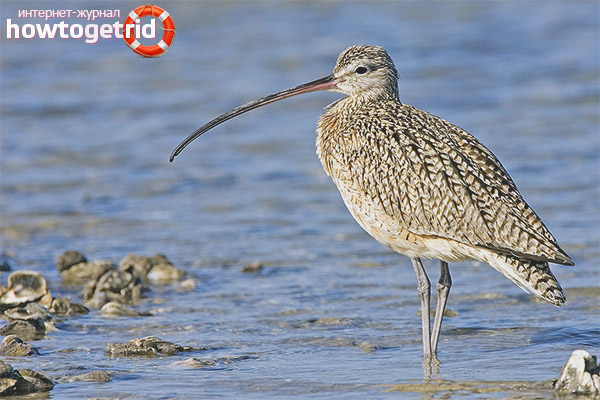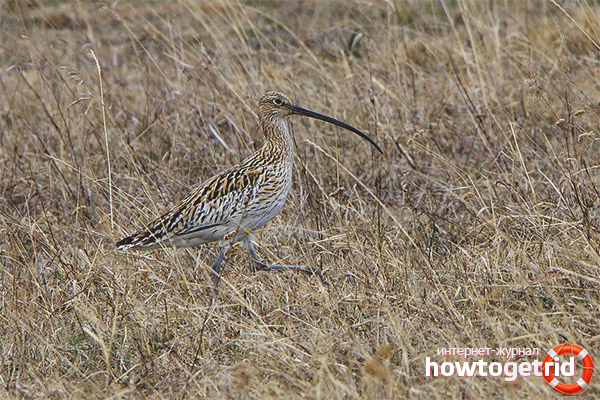The content of the article
Curlew is understood to mean a bird belonging to the snipe family. If you assign a detachment to these individuals, it will be called Charadriiformes. Few have heard about these birds, so in today's article we study the main aspects associated with these birds. The main feature, of course, is considered to be an excessively long and bent beak, as well as an interesting coloring of plumage. But let's not get ahead of ourselves, we will study everything in order of priority.
Curlew
- By weight, birds can reach 0.9-1.1 kg. Individuals grow up to a maximum of 65 cm, and the wingspan varies within 1 m. It has already been mentioned that a distinctive characteristic of birds of this family is considered to be a bent and elongated beak. Moreover, in females, it bends more strongly than in representatives of male affiliation.
- Curlews are most often found in the natural environment, brownish in color with gray and buffy spots. However, the plumage can have a different shade, for example, gray, whitish or beige with brown. Birds are found in Asian countries, as well as in the north and central part of Europe.
- By nature, these individuals love marshland. Therefore, when the birds nest, they choose such an environment for the construction of a dwelling for future offspring. They need some water, silt, reeds or other vegetation along the edge of the source. Often found on peatlands.
Curlew
- There are many different members of the family, for example, curlew. These birds differ from large individuals in small dimensions, as well as in their habitat (they prefer to settle in the Urals, in Kazakhstan).
- When it becomes cold in the country of residence, birds gather and leave the region. They go to countries with a mild climate, found off the coast of the Mediterranean Sea. Ornithologists researching these birds believe that babies are on the verge of extinction.
- When small curlews begin to build nests, they select open areas. They are preparing for the reproduction of offspring in the meadow near the Siberian rivers. Dwellings are located in small holes specially dug for these purposes.
Curlew
- It differs from its large and small brothers. In terms of wingspan, the wings reach a mark of 80 cm, the length of the hull varies within half a meter, and the weight is 0.5 kg. (males) and 0.6 kg. (females).
- The peculiarity of this variety is the color of the case. The parietal region is brown with black patches, separated by a strip of whitish tone. The beak is not so long, and the arches above the eyes are pigmented light.
- Like all other birds from this family, individuals live in marshy areas of European countries. But they prefer to build a house for posterity not in an open, but in a wooded area, so that there is a water source nearby.
Curly Curlew
- In its external characteristics, it does not practically differ from large individuals. Except that the size differs, it is slightly smaller. The beak is also shortened and does not bend much.
- Prefers to settle in meadow plots with swampy soil. You can find individuals on peatlands, as well as in birch or aspen forests. When it comes time to go for the winter, fly to Morocco or nearby regions.
- Today, it is this variety of curlews that is considered to be the rarest, endangered, therefore it is seriously protected.A distinctive characteristic is the fact that black marks are located on the bird's body.
Curlew
- As the name implies, individuals live in the vastness of our homeland. In terms of wingspan, the indicators are up to 100 cm. Elongated legs and the back of a dark brown tone are considered a distinctive feature. The belly of the birds is light, almost whitish.
- The beak, by analogy with individuals of a large type, is strongly bent and elongated. Since individuals live in Russia, they prefer to nest here. But they can occasionally fly to Korea or China.
- Due to the fact that this species was previously engaged in the construction of a dwelling for offspring in open areas, hunters, foxes, and dogs began to destroy it.
Eskimo Curlew
- The species that has long been represented has been considered the most extensive in terms of its habitat and abundance. It is common in the United States of America, as well as Canada.
- But since curlews were constantly the prey of hunters, they were practically exterminated. For more than 50 years, the Eskimo representatives have not caught the eye of man.
Lifestyle
- The considered representatives of birds lead, one might say, a social lifestyle. Almost all the flights that birds make take place at night. Moreover, the presented individuals form simply huge colonies.
- In places of wintering, such birds accumulate in large quantities. Most of the time during the day the birds are looking for food, it can be replaced that such individuals walk impressively in the open. Birds from time to time lower their beak in silt or sand.
- It is worth noting that the rhythm of life of Curlews directly depends on the ebbs and flows, and not day and night, like most birds. As soon as the water departs from the shores, the presented individuals go on an active search for food.
- As soon as the tides come, these birds go on vacation. At this time, the birds begin to make very beautiful and unusual sounds. Their singing can be compared to playing the flute. For wintering, individuals travel to hot countries. Often there is a Mediterranean climate.
- In Russia, these individuals can be seen at the beginning or in the middle of spring. If one of the curlews notices an imminent danger in the form of a carnivorous beast, the bird will certainly warn the relatives with a loud cry. Sometimes sounds are like neighing a foal.
- For a night's rest, the individuals in question go to secluded places. Often they are presented in the form of coastal thickets and dense grass. In such places, birds are inaccessible to predators and humans. Represented individuals prefer to adhere to seasonal migrations. Therefore, they do not lead a sedentary lifestyle.
Breeding
- As mentioned earlier, the individuals represented are social birds. Therefore, they nest with large families, and couples form at this time. Individuals build nests together. They are small indentations in the ground. Birds shelter the house with feathers, dried grass and twigs.
- The female carries out laying approximately in the middle of spring. No more than 4 eggs are obtained at a time. Young animals are born with plumage. After some time, the chicks already with their parents go in search of food.
- Young growth remains with adults until they learn to fly. Until this moment, they try to hide in dense thickets from predators and other enemies. After about a month and a half, the chicks become on the wing and begin to fly independently and look for food.
The individuals of this family have their own characteristics that distinguish them from all other birds. The main feature, of course, is a bent and long beak.
Video: Curlew (Numenius arquata)












Submit